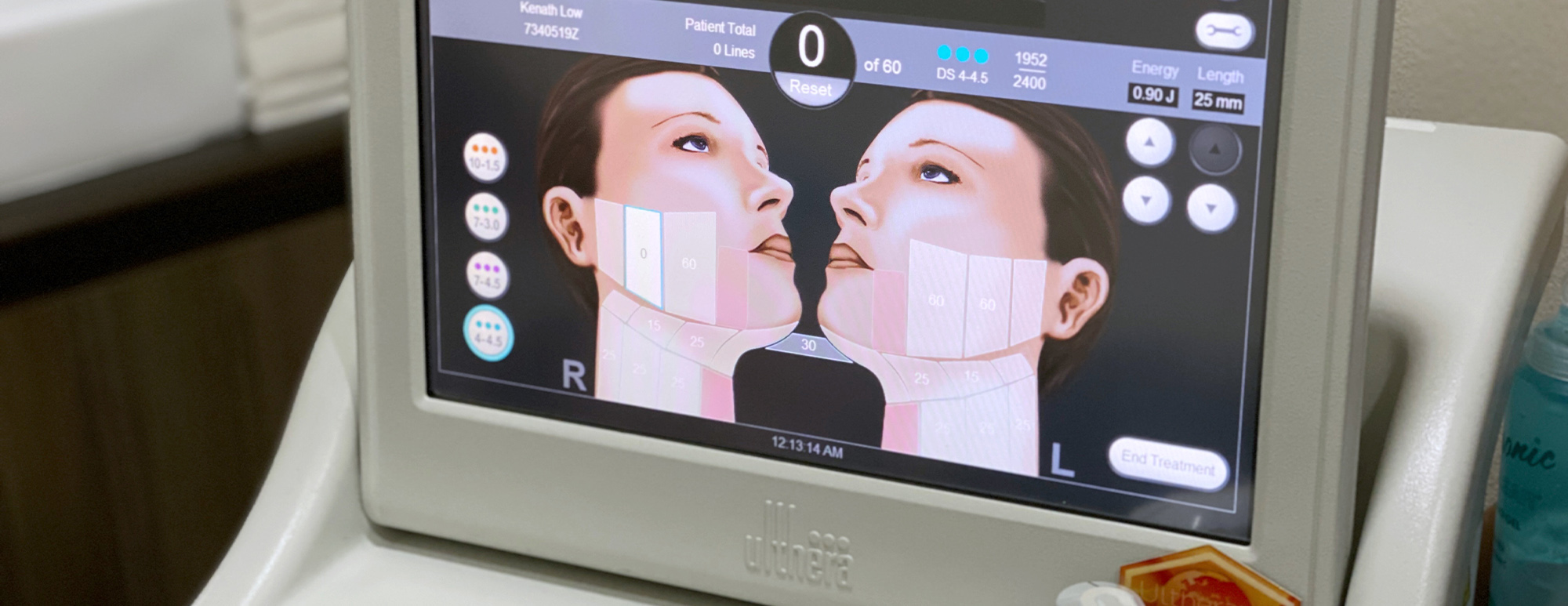Ultherapy is perhaps one of the most well-known in-clinic treatments to lift and tighten skin, and it’s particularly popular because it’s non-invasive (no injections or surgery!) and has little to no downtime. It works by stimulating the production of the body’s own collagen and elastin, so the results are incredibly natural-looking, and can last for up to two years. Furthermore, for most patients, only one treatment is needed. You can read more about it here.
But the main question everyone wants to ask: is it painful? Well, pain is subjective and our threshold for pain is different. I previously tried HIFU (it was painful but not intolerable), CoolMini (no pain whatsoever for me!), and Profhilo (I’m never doing this again) — and I’ve been told that Ultherapy is most similar in discomfort to HIFU as it has the same procedure of “zapping” the face.
As I tried HIFU not too long ago, I assigned NYLON’s Associate Publisher, Kenath, to give Ultherapy a try. We visited Dr Justin Sii at S Aesthetics Clinic for this treatment.

Above: machine used for Ultherapy treatment. It uses Micro-focused ultrasound energy to stimulate new collagen production.
BEFORE THE TREATMENT
These are the steps that take place before the actual treatment with the machine starts.
Step 1: Consultation with Dr Sii.
Step 2: Photos of the face are taken for reference.
Step 3: Numbing cream is applied to the whole face and left on for 20-30 minutes. Oral painkiller is given as well, but this is optional.
Step 4: Ultrasound gel is applied to the face.
Step 5: The procedure begins.
DURING THE TREATMENT
Kenath started the treatment feeling excited and curious, especially considering that this was his first time getting a procedure like this done. He says that it didn’t feel so much like an electric zap, but more like a small prickly feeling under the skin, and a little bit warm (the ultrasound energy goes into the skin so it may feel a little warm under the skin. But the surface layer does not get burned). Most importantly, he said that it was not painful at all, and the procedure on some areas of the face were in fact ticklish. Kenath adds on that for anyone who has done tattoos, the sensation is mildly similar. He did comment though that if I were to do this treatment, I would probably have a fair bit of discomfort throughout the procedure — I don’t doubt this.
Dr Sii shares that for most patients, the discomfort is bearable, and he hasn’t had anyone “screaming in pain” or abandoning the treatment halfway. He mentions that Ultherapy is particularly effective for the lower sides of the cheeks where they tend to sag. The treatment tightens and lifts loose skin, including at the under-chin area and jawline. It delays the sagging of skin and interrupts the ageing process. Also, it’s a very safe treatment; the energy level can be adjusted during the treatment, plus its real-time visualisation screen allows doctors to see one’s layers of the skin, allowing the treatment to be fully customisable, and tailor-made to each patient’s unique anatomy.

Above: The Ulthera machine allows Dr Sii to Visualise the different layers of the skin in real-time for precise delivery of ultrasound energy to target tissues.
Apart from Ultherapy being a safe and effective treatment, do also choose the right doctor to perform it for you. Dr Sii says, you don’t want to unintentionally hit blood vessels which might result in bruising, and one should avoid the bone as it’ll be very painful (ouch!).
On average, the whole procedure (from consultation to finish) takes 1 to 1½ hours. For those like Kenath with a high tolerance for pain, it takes just 45 minutes.
AFTER TREATMENT
The improvement in the face is seen progressively over 6 months, with results appearing as soon as 2 to 3 months from the time of treatment. And because it’s a gradual change, the face looks completely natural — just better and better over time. With Ultherapy, it’s necessary to note that we’re not talking about immediate improvements but progressive and long-term benefits, so understand this to manage your expectations once you leave the clinic.
For some individuals, there may be slight downtime, which is typically just a mild ache and swelling around the cheeks. Dr Sii also recommends that after the treatment, one should avoid sun exposure and to moisturise the skin.
NOTES FROM THE DOCTOR
While Ultherapy is suitable for many people, Dr Sii says to avoid it if you have the following conditions:
- Metal implants (eg. accident patients). The metal might reflect back the ultrasound energy and it may cause skin burns. For ultrasound it’s all about precision.
- Bad acne breakouts (the heat will make it worse).
- Those with open wounds.
- Those who are aged 70 and above with very saggy skin. For these individuals, consider a face lift instead.
- There is no specific age for Ultherapy, as it depends on the individual’s overall skin health and laxity. Dr Sii generally won’t recommend this for anyone below 25, as ageing effects typically become more apparent only in late 20s onwards.
You can find out more about Ultherapy HERE. S Aesthetics clinic is located at Scotts Medical Centre (pacific Plaza), #07-07 (t: 62350338). WWW.SAESTHETICSCLINIC.COM











You must be logged in to post a comment.